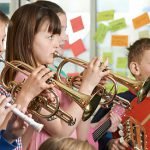In your child’s classroom
Exploring music
Third graders work to develop their understanding of pitch, melody and rhythm by singing, playing instruments and exploring creative movement. You can expect your child to learn about famous musicians and the instruments in an orchestra. Through these activities, she develops her understanding of the artistic, cultural, scientific and mathematical foundations of music.
Research has shown that the benefits of music education include improved reading and reasoning ability, self-esteem and vocational preparation. Paul Bakeman, our teacher consultant and award-winning music teacher, adds: “Recent research done at the University of California, Irvine, indicates that young children involved in consistent music instruction have a greater ability to grasp concepts that are also essential to the understanding of math and science.”
Music may not be taught as a separate subject in some schools, but most states require that it be included in the curriculum. Most states have music standards that are based on the Most states have music standards that are based on the National Standards for Arts Education.
Singing
Your third grader is likely to sing traditional and folk songs. Many songs will be connected to the holidays. Others will reinforce what your child is learning in class. Typical songs include “America the Beautiful,” “Yankee Doodle” and “Rocky Mountain.” Your child sings alone and with a group, blending his voice with others and singing in rounds. He sings expressively, on pitch (high and low) and with correct dynamics (loud and soft). He sings an increasing number of songs from memory and with improved accuracy. He may create songs based on a poem or nursery rhyme.
Playing and listening to instruments
Third graders play musical instruments. They can begin a simple melody instrument such as the harmonica. Some, but not all, are ready for the recorder.
They can play more complex melodies on xylophones, individually and in a group. You can expect your child to work with rhythm to find a steady beat. He will be able to maintain a steady beat as he plays an instrument alone and in a group. He can improvise short melodies on a xylophone to the rhythm of poems or chants, given a set of pitches to work with.
You can expect your child to learn the characteristics of the musical instrument families: string, woodwind, brass, percussion and keyboard. He listens to the instruments and learns how they work together in an orchestra.
Moving to music
Your child gets many opportunities for creative movement. She may invent hand and body movements to accompany songs, showing her understanding of rhythm, beat and the mood of the music. She will also learn dances from other cultures or eras. “Third graders love to participate in folk and traditional dances,” Bakeman says. “It is often interesting to watch these students practicing their socialization skills as they attempt these dances that usually involve pairing up with someone else.”
Using the vocabulary
In a rich music program, third graders learn to use the vocabulary of music, using words such as pitch, meter, rhythm, tempo and melody. They also learn to understand how music communicates feelings. Your child will use words such as happy, sad, excited or scary to describe the emotions portrayed in music.
Learning notes
Third-grade students are able to develop recognition of musical notation. They begin to read music from the treble clef staff, identifying and writing individual pitches. “Third graders also practice drawing the treble clef symbol, staff and other musical symbols,” Bakeman adds. “They can identify these symbols and explain their purpose and usage.”
Studying famous musicians
Students should be exposed to music of various styles, eras, genres and cultures. They learn about famous musicians of the past, such as Frédéric Chopin and Ludwig van Beethoven, as well as contemporary musicians and those from various cultures. They learn that being a musician or composer can be a career choice.
What to look for when you visit
- Musical instruments, such as recorders, harmonicas, drums, cymbals, triangles and rhythm sticks
- Sound recordings from a wide variety of cultures, styles and eras
- Music-related books
- Puppets or other props used for singing or movement games






